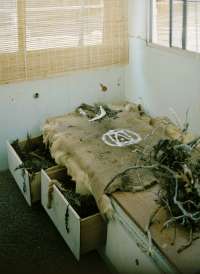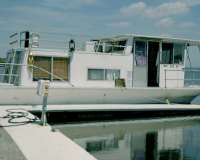In July 2010, a draft of this artwork was created as an experimental 24-hour site-specific installation in Far Rockaway, Brooklyn, curated by Jess Shaefer, former Director of Hendershot Gallery, NYC. The final and complete boat, as outlined below, has not yet been realized.
Ever since the Atlantic Ocean carried the first settlers to America, it has been a place of inspiration for this country's greatest authors, such as Ernest Hemingway and Herman Melville. America’s vast lore and literature of this ocean is a testament to its complex relationship with it.
This installation creates an environment in which viewers are confronted with textures, mythologies, collective memories, and primal fears of the sea. Using a vintage 1960’s houseboat as the installation space, factual histories and biologies meet fantasies and dream-worlds created by the artist. The boat must be docked in a harbor or marina for an extended period of time for visitors to enter. The experience of coming aboard, and the movement of the boat on a body of salt water while being securely moored to the dock, is the crucial conceptual underpinning of the piece.
Just like the ocean itself, the narrative environment of the installation space distorts the notion of linear time; at once, this boat is reminiscent of a trailer in its mid-century fabrication and construction by industrial materials, but the interior is so dream-like and literary that it calls to mind both the Moby Dick narrative, and also a tangible myth much more primal and ancient.
Inside the cabin are a number of situations for the viewer to experience. The first experience aboard is that of the site-specific sculptural assemblages, which immediately greet the viewer’s vision and set the tone of the space. Large piles of dried kelp and seaweed pour out of the dresser drawers in the sleeping cabin; branches and animal hides sit atop the bed; fishing nets entwine, distort, suffocate sections of the interior architecture; jars of dried sea-life, herbs, lichen, and various cooking implements neatly line the small Formica kitchen; old maritime books and maps are found on the built-in bookshelves. Other details such as a black rotary telephone, integrated seating areas for visitors, and a crackling CB radio toy with the viewer’s suspension of disbelief.
Which brings us to the experience of sound; In addition to the CB radio crackle, we hear amplified ambient sounds of the harbor, facilitated by microphones and speakers. The lapping of waves, the rocking of the boat and its contents, and the sound of foghorns: These sounds are deeply essential to the experience, as sound and collective memory of the ocean are deeply entwined. In tendem with such sounds, a fog machine fills the cabin with thick haze during regular intervals; the red glow of the boat’s fog light illuminates with an abstracted glow during these times.
Additionally, a vintage 1970’s color television in the cabin plays a grainy video loop of the artist performing rituals as the character of the Sea Witch. At night, the boat is lit by candlabras and antique lanterns. Torches are positioned along the dock towards the entrance. No matter what time of day the visitors may approach the boat, their experience is one of full immersion within this complete, staged environment.
The boat should be docked and open to the public for at least one month, during which it is open from mid-afternoon to early evening, as the change from late afternoon sun gives way to the engulfing darkness of night.
A visual artist trained in photography as well as film, video and performance, Mollie McKinley’s work (b. 1981) has elicited comparisons to the early works of director David Lynch, and to the texturally poetic style of filmmaker Andrei Tarkovsky.
Early American history, ancient alchemical symbolism, literature, and neo-primitivism all inform the narratives within her artworks. Her most recent work, an experimental film entitled LOVEFISH, will screen at Anthology Film Archives on June 7, 2011. It has been described as a “strange and haunting film is inspired by dreams and their Jungian symbols, as well as by Diana, the virgin huntress of Greco-Roman mythology. McKinley deftly tugs on our ancestral strings with a set of surreal imagery that hovers somewhere between art performance and ancient ritual. By showing us an interpretation of who we were, McKinley offers an insight into what we’ve become.” (Phillip F. Clark, “The Artpoint,” December 2010).
Her website is www.molliemckinley.com
In July 2010, a draft of this artwork was created as an experimental 24-hour site-specific installation in Far Rockaway, Brooklyn, curated by Jess Shaefer, former Director of Hendershot Gallery, NYC. The final and complete boat, as outlined below, has not yet been realized.
Ever since the Atlantic Ocean carried the first settlers to America, it has been a place of inspiration for this country's greatest authors, such as Ernest Hemingway and Herman Melville. America’s vast lore and literature of this ocean is a testament to its complex relationship with it.
This installation creates an environment in which viewers are confronted with textures, mythologies, collective memories, and primal fears of the sea. Using a vintage 1960’s houseboat as the installation space, factual histories and biologies meet fantasies and dream-worlds created by the artist. The boat must be docked in a harbor or marina for an extended period of time for visitors to enter. The experience of coming aboard, and the movement of the boat on a body of salt water while being securely moored to the dock, is the crucial conceptual underpinning of the piece.
Just like the ocean itself, the narrative environment of the installation space distorts the notion of linear time; at once, this boat is reminiscent of a trailer in its mid-century fabrication and construction by industrial materials, but the interior is so dream-like and literary that it calls to mind both the Moby Dick narrative, and also a tangible myth much more primal and ancient.
Inside the cabin are a number of situations for the viewer to experience. The first experience aboard is that of the site-specific sculptural assemblages, which immediately greet the viewer’s vision and set the tone of the space. Large piles of dried kelp and seaweed pour out of the dresser drawers in the sleeping cabin; branches and animal hides sit atop the bed; fishing nets entwine, distort, suffocate sections of the interior architecture; jars of dried sea-life, herbs, lichen, and various cooking implements neatly line the small Formica kitchen; old maritime books and maps are found on the built-in bookshelves. Other details such as a black rotary telephone, integrated seating areas for visitors, and a crackling CB radio toy with the viewer’s suspension of disbelief.
Which brings us to the experience of sound; In addition to the CB radio crackle, we hear amplified ambient sounds of the harbor, facilitated by microphones and speakers. The lapping of waves, the rocking of the boat and its contents, and the sound of foghorns: These sounds are deeply essential to the experience, as sound and collective memory of the ocean are deeply entwined. In tendem with such sounds, a fog machine fills the cabin with thick haze during regular intervals; the red glow of the boat’s fog light illuminates with an abstracted glow during these times.
Additionally, a vintage 1970’s color television in the cabin plays a grainy video loop of the artist performing rituals as the character of the Sea Witch. At night, the boat is lit by candlabras and antique lanterns. Torches are positioned along the dock towards the entrance. No matter what time of day the visitors may approach the boat, their experience is one of full immersion within this complete, staged environment.
The boat should be docked and open to the public for at least one month, during which it is open from mid-afternoon to early evening, as the change from late afternoon sun gives way to the engulfing darkness of night.
A visual artist trained in photography as well as film, video and performance, Mollie McKinley’s work (b. 1981) has elicited comparisons to the early works of director David Lynch, and to the texturally poetic style of filmmaker Andrei Tarkovsky.
Early American history, ancient alchemical symbolism, literature, and neo-primitivism all inform the narratives within her artworks. Her most recent work, an experimental film entitled LOVEFISH, will screen at Anthology Film Archives on June 7, 2011. It has been described as a “strange and haunting film is inspired by dreams and their Jungian symbols, as well as by Diana, the virgin huntress of Greco-Roman mythology. McKinley deftly tugs on our ancestral strings with a set of surreal imagery that hovers somewhere between art performance and ancient ritual. By showing us an interpretation of who we were, McKinley offers an insight into what we’ve become.” (Phillip F. Clark, “The Artpoint,” December 2010).
Her website is www.molliemckinley.com

